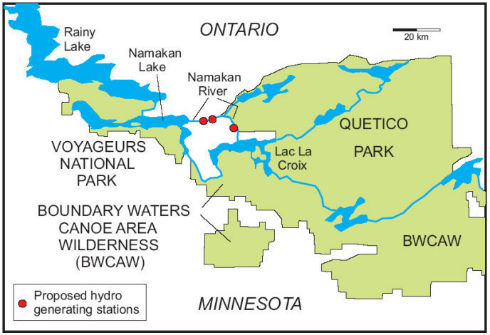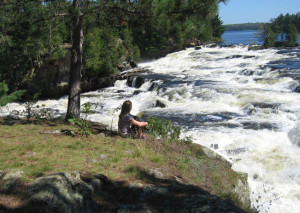
A dam that would be built at waterfalls between Quetico Park in Ontario and Voyageurs National Park in Minnesota has new life, but may also have hit a final roadblock.
Ontario’s government has turned down a request by the Lac La Croix First Nation for the public to pay $16 million to connect the dam to the electrical grid, which proponents say is necessary to make it financially feasible. The dam is seen as an economic development project for Lac la Croix, which is partnering with a power company and a Toronto businessman to advance the project.
According to an article in the Atikokan Progress, in a new partnership between the First Nation and Gemini Power Corp., Lac La Croix “will assume full ownership within 20 years of commissioning (after Gemini Power has earned a return on its investment), and will realize a steady revenue stream, about 20 construction jobs, and two permanent jobs, from the project.” Gemini Power states the dam would produce enough electricity for about 2,800 homes.
Transmission troubles
If there is a dam, there has to be a way to get the power from the river to the electrical outlet. In a story in the Toronto Star, Energy Minister Bob Chiarelli said the government flatly refuses to pay for a transmission line, citing policies that require new electricity projects to pay for connections to the grid.
“Every single [feed-in] contract has a procurement for X-amount price. And every contract requires that the responsibility and cost of transmission to be on the proponent … so no provincial entity is required to pay or provide the transmission,” he told the Star.
Existing power lines between the community and the main power grid are insufficient, and the Lac La Croix government says it represents a broken promise by the provincial utility.
In a column strongly advocating for the dam, writer Martin Regg Cohn says that when the community was first connected to Canadian electricity in 1993, the lines were supposed to be sufficient both to bring in enough power for the community and eventually feed electricity out to the grid. Neither is the case, with frequent disruptions in electricity another of the band’s complaints.
But the terms of the band’s 2010 feed-in contract with the province specifically require the First Nation to pay for the upgraded connection.
‘Irreversible damage’

Many environmental groups have partnered to oppose the dam, saying it would damage the free-flowing Namakan River’s wild nature and threaten the region’s fish.
On its Facebook page, the anti-dam coalition cites a list of concerns: “With its current proposal, the High Falls hydro-electric development will directly impact 8 km of the Namakan River, destroy its wilderness character, irreversibly damage its fragile ecosystem, threaten critical Lake Sturgeon habitat and migration patterns, impair water quality throughout the Lake of the Woods and Rainy River watersheds, and negatively affect the ecological integrity and value of the Quetico-Superior wilderness area.”
In 2009, the Quetico-Superior Foundation (which publishes Wilderness News) took the rare step of formally opposing the project. At the time, president Jim Wyman wrote that “the relatively small amount of power that would be generated does not justify the irreversible impact to the river.”
The anti-dam coalition has advocated for increased economic development support for Lac La Croix, saying other options have not been examined.
After an environmental review which did not satisfy environmental concerns, financial difficulties, and other problems, the project was thought to have been cancelled in 2013. But on its Protect the Namakan web page, Voyageurs National Park Association states, “We were surprised to learn recently that the project is continuing to be pushed forward. As a result, VNPA and Canadian and American environmentalists have become re-engaged. We are seeking clarification on the current status and details of the project and are asking the Ontario government to work with the community to seek economic development opportunities that do not threaten the ecological integrity of the area and its wilderness parks.”
While the transmission line issue represents an impasse for the project, pro-dam columnist Cohn says another consideration is that the line will have to be replaced soon anyway, so the province ought to do it now and enable the dam project to go forward. Ontario’s government says it has asked the First Nation to meet and discuss options, but the province’s Premier says the band has not yet responded to the request.
Read more in Wilderness News Summer 2014 issue.

